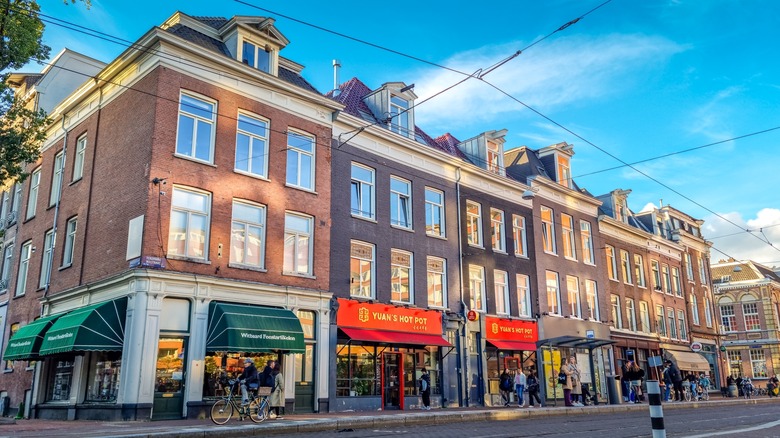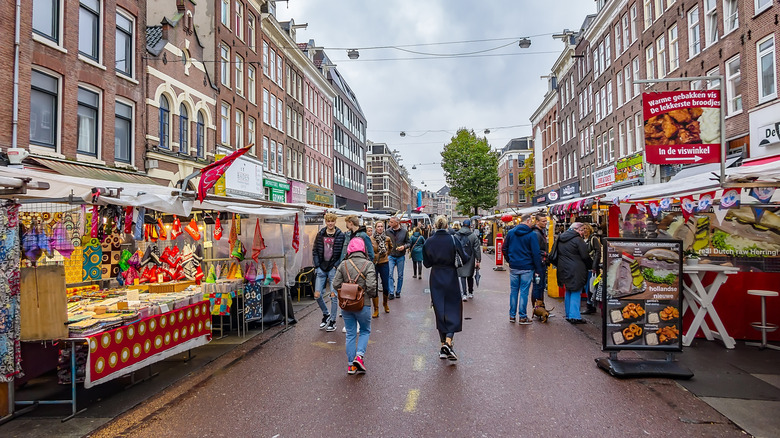Amsterdam's Quirky Bohemian Zone Away From The Touristy Canals Has Artisan Shops, Eclectic Eateries, And Pubs
Just south of the city center's canal ring, Amsterdam's lively Latin Quarter bursts with a bohemian, multicultural flair that's welcoming to all. De Pijp, or "The Pipe" as it translates, started out as a working-class neighborhood in the 1800s, housing primarily Spanish and Jewish families. But today, it hosts a plenitude of the city's creative and student populations, and some tourists say it's the Dutch capital's best neighborhood to find accommodation. Maybe you've come to witness the Netherlands bursting with tulips in spring? Maybe you've come to party and experience the loosely regulated lifestyle enjoyed by the Dutch? Either way, De Pijp is your perfect launch point.
From Central Station, De Pijp is about a five-minute train ride or 45-minute walk. It's just far enough out to be residential and not overrun by tourists, but still within walking distance of all the main attractions (like the Anne Frank House, Rijksmuseum, and Vondelpark). It's retained its lively, forward-thinking atmosphere of the old days — full of one-of-a-kind shopping streets, historic pubs, and international restaurants — while maintaining the character of a safe haven away from the hubbub, welcoming to all kinds of visitors. Plus, it has its own sizable city park and hosts the Heineken Experience in the beer giant's original brewery.
Culture and creativity collide in the heart of De Pijp
Another reason De Pijp makes a great home base for your Dutch getaway? There's so much to see and do in its bustling streets. It's there you'll find the Albert Cuypmarkt, an enormous open-air market that consumes the entirety of Albert Cuypstraat for four whole blocks. Open 9 a.m. to 5 p.m. Monday through Saturday (as of this publication), it's one of the top experiences you can only have in Amsterdam, according to travelers. Up to 50,000 customers can flood its stalls in a day, looking to take home Dutch cheese, clogs, and local street foods like raw herring, baby pancakes, and fresh-baked stroopwafels.
A five-minute walk away, the Heineken Experience offers tours of its 19th-century brewery-turned-museum, where aleheads can learn the history of "the world's most famous beer" and end with a pint at the rooftop beer garden overlooking De Pijp. In the center of the district, Sarphatipark offers a tranquil escape from city scenery among weeping willows, bridges over still waters, and flowers in the spring. There's also a number of arts hubs sprinkled through the streets, including the Rialto independent cinema, CC Amstel theater, De Appel modern art center, the small pop music stage at Cinetol, and the De Dageraad 20th-century architecture museum.
If you're after boutique shopping and souvenirs, Gerard Doustraat is littered with artisan boutiques selling handmade jewelry, design-forward homewares, vintage clothes, ceramics, and more. Just be cautious as you approach Ruysdaelkade along the Boerenwetering canal — it's known as the "locals' red light district."
Eat, drink, and linger like a local in De Pijp
As a part of town that somehow balances laid-back life with a happening atmosphere, De Pijp rules Amsterdam's brunch scene every weekend. The neighborhood has so many great options to choose from — like omelettes at Omelegg, traditional Dutch fare with a side of great street scenes at De Wasserette, and delicious coffee at clean-cut Locals All Day Brunch.
Another comforting custom is the neighborhood's "brown bars," smoky pubs rich with dark wooden decor and a murky aura of yesteryear, where Belgian beers and malty, juniper genever tend to be the drinks of choice. Dopey's Elixir on Lutmastraat is the oldest in the area, founded in the '70s, but Cafe Gollem is another local institution worth visiting. Then for the other side of cafe culture, there's the cannabis "coffeeshops" Amsterdam is famous for. Katsu Coffeeshop & Galerie, just near Sarphatipark, is one of the most popular in the whole city for its affordable menu and chill aesthetic.
There's also a field day's worth of places to wine and dine come evening, with the exotic flavor of the neighborhood still represented at venues like Miri Mary Indian Restaurant, Brio (where Italian food is done up with a modern flair), Sjefietshe ceviche bar, and takeaway at Tjin's Toko Indonesian mart. You could also check out Kaasbar Amsterdam, a cozy restaurant with Amsterdam's one-and-only cheese train bar. For drinks, Brouwerij Troost offers the unique experience of a brewery housed inside a former monastery, and Bar Mokum is a safe haven where cocktails are king.


